DINKY 359 EAGLE FREIGHTER (1975-1981):
Two models were released in 1975, first the 359 Eagle Transporter and then later the 360 Eagle Freighter. Both of these models were licensed from Gerry and Sylvia Anderson’s TV production Space:1999, a UK science fiction television series that originally aired from 1975 to 1977.
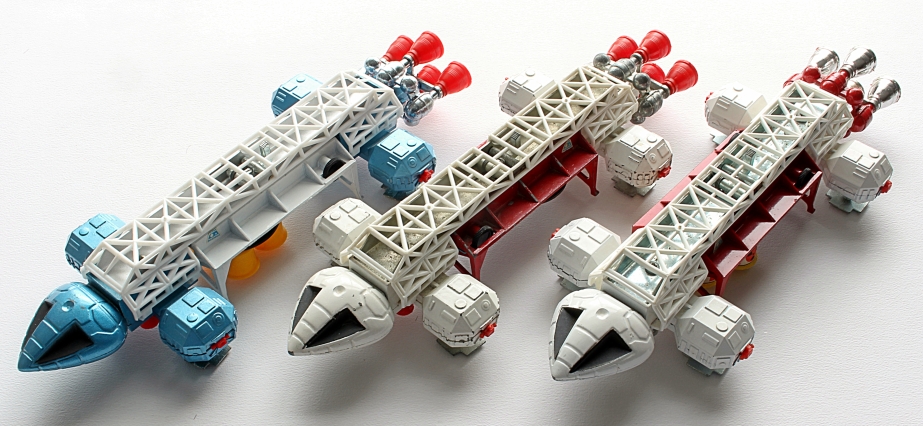
The Dinky Eagle Freighter carried cylinders of hazardous cargo, initially labelled with a radioactive symbol but later as a fuel waste container.



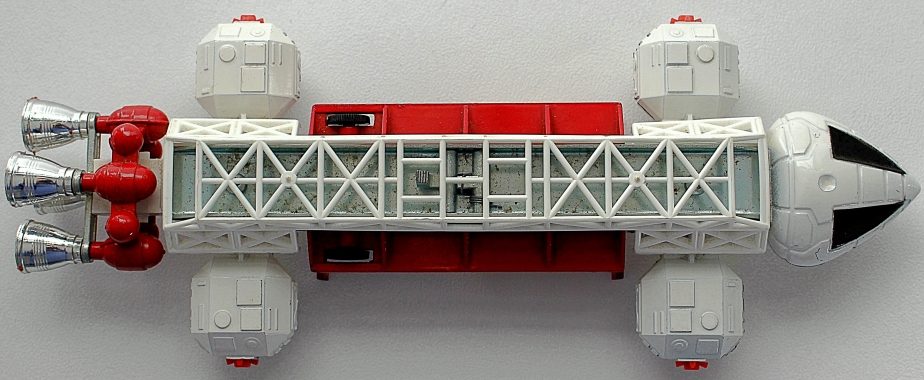
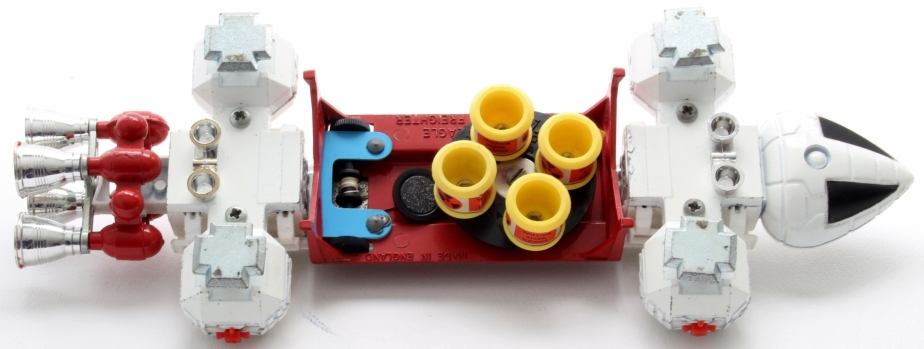
The pod could be removed and the containers lowered or raised via a manual winch. The grabber was a magnet and the tops of the containers were metal.
IN THE TV SERIES:
The Eagle was designed by Brian Johnson who had worked with Gerry Anderson on Thunderbirds in the mid-1960s and had then produced the spacecraft for the 1968 film 2001: A Space Odyssey.
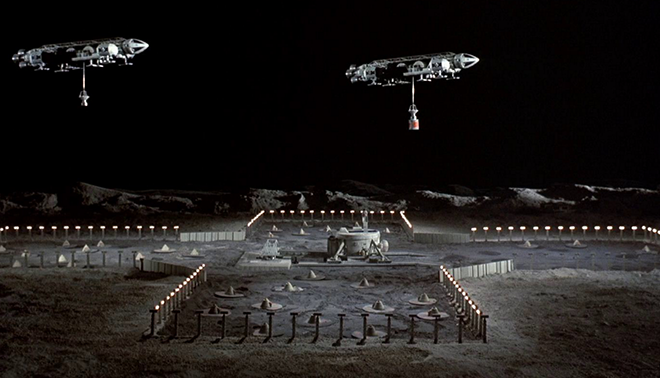
The Eagles served as the primary spacecraft of Moonbase Alpha, which had a fleet of them, and were used to explore alien planets, defend Moonbase Alpha and to transport supplies and other items to and from the Moon.
Various types of module could be attached to the Eagles including:
- Transporter: Used to transport supplies and equipment
- Rescue: These Eagles are recognisable by their vertical red stripes
- Freighter: These specialised Eagles are used to transport dangerous nuclear waste to the Nuclear Disposal Areas. The waste canisters are carried in a ‘pallet’ type pod which links to a conveyor belt at the disposal areas.
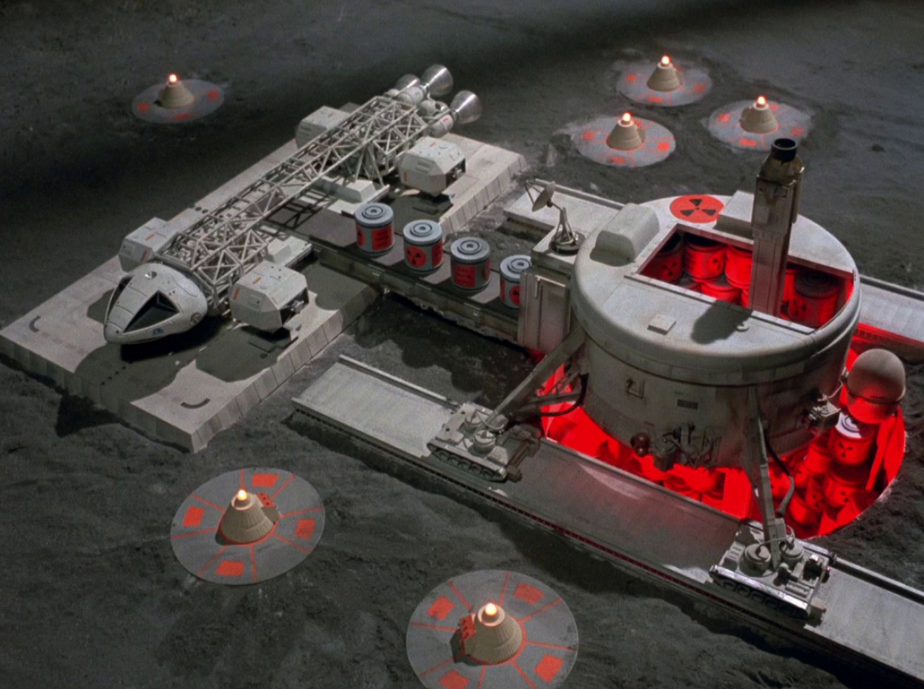
PROP V ACTUAL:
The model of the Eagle used in filming was built in four scales: by the end of the series, there were three 44-inch (110 cm) Eagle models, two 22-inch (56 cm) Eagles, one 11-inch (28 cm) Eagle, and a 5-inch (13 cm) Eagle.
The white Dinky model was a pretty good copy of the actual prop.
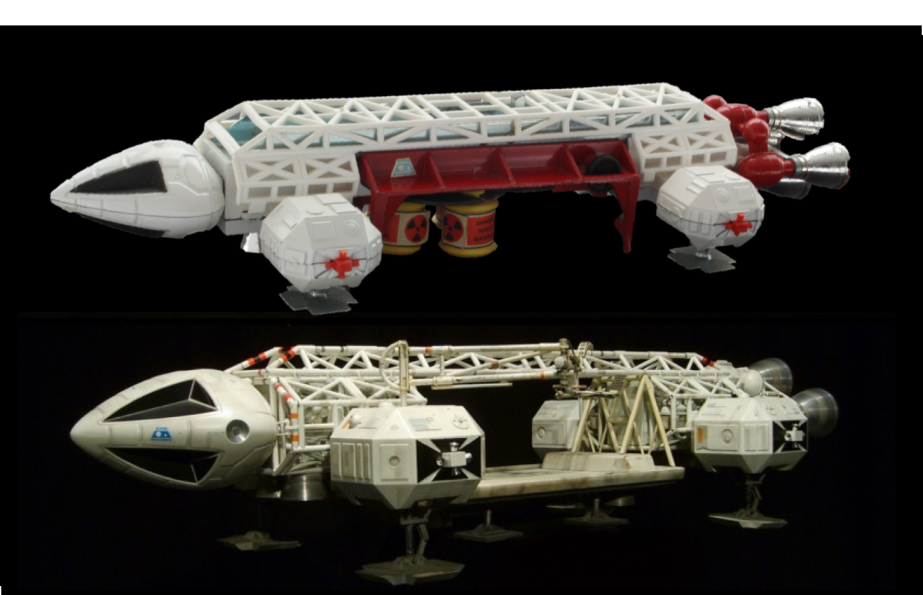
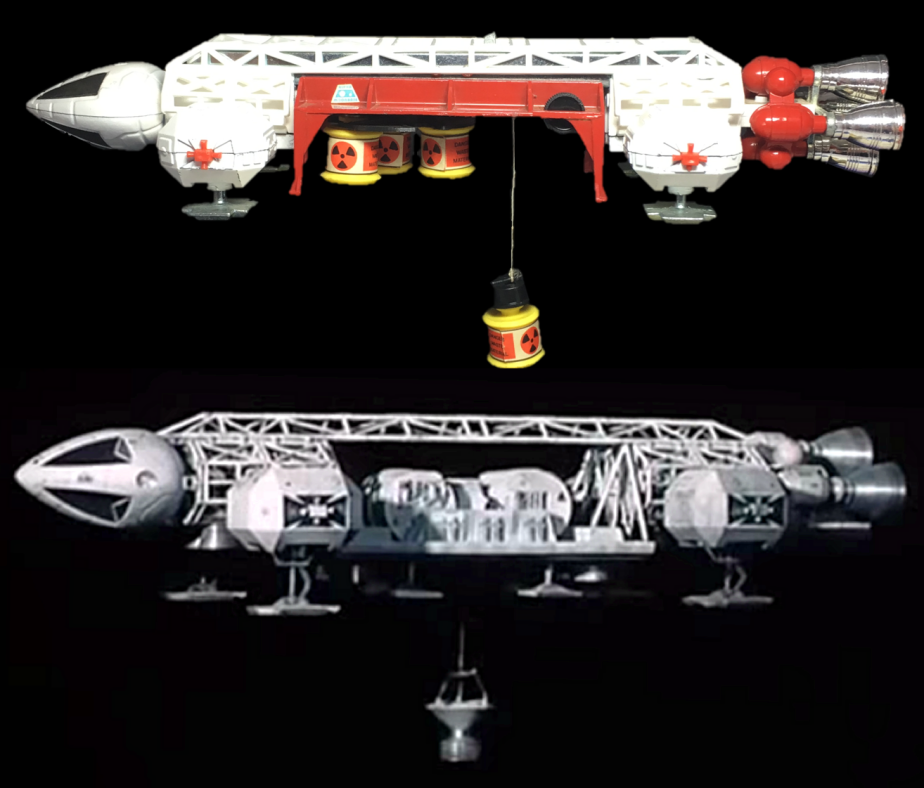
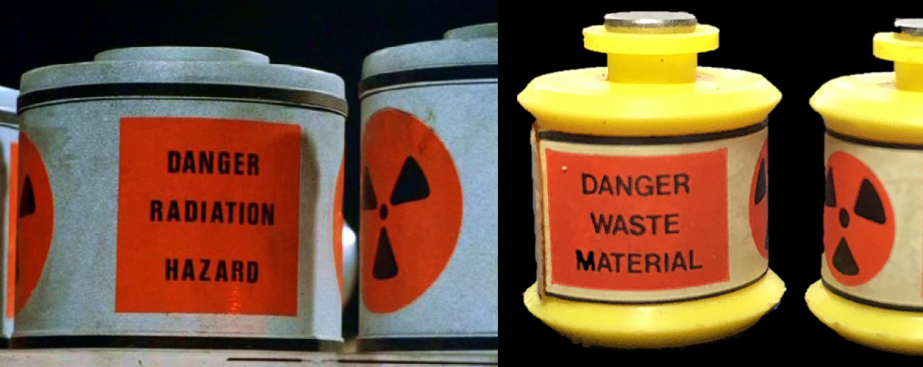
VARIANTS:
There were three main Eagle Freighter variants. The first version had a white chassis with chromed engine nozzles and red engines, the second a white chassis with red nozzles and silver engines and the third and last version had a blue chassis with red nozzles and silver engine.
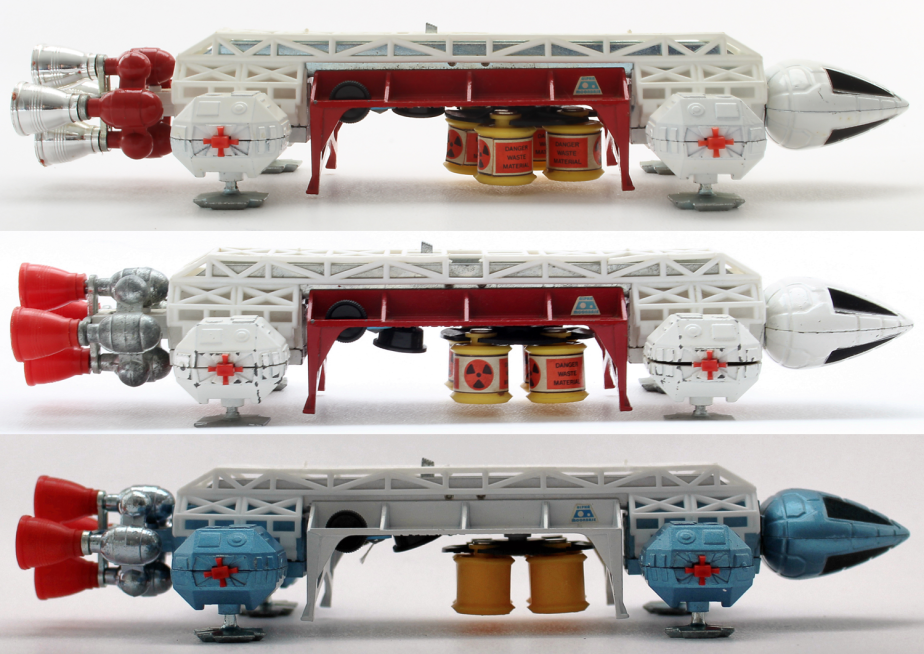
An all white Eagle freighter is sometimes seen but was not sold by Dinky. It is in fact an amalgam of the green Transporter’s pod and the white Freighter’s chassis.
The 359 Eagle Transporter chassis was the same as the 360 Eagle Freighter chassis and had the same body variations.
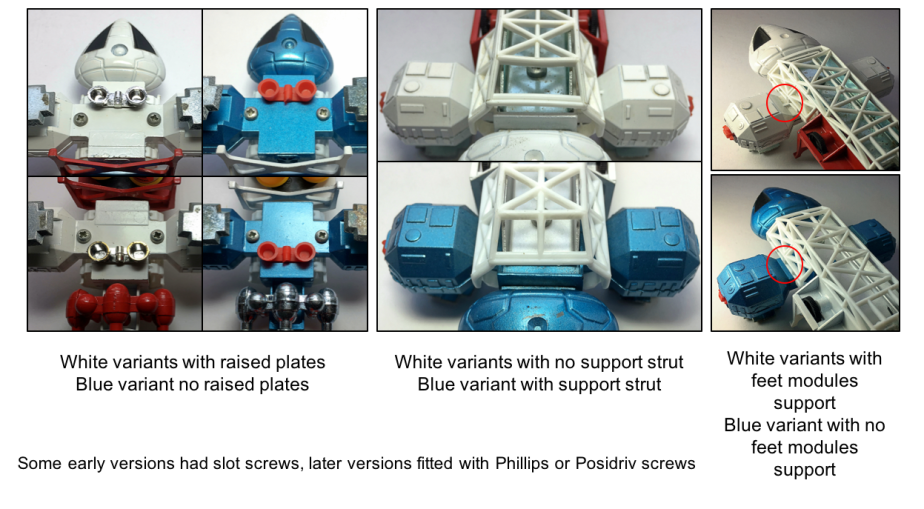
The Freighter pod was the differing factor from the Transporter. It was designed to carry yellow plastic containers, held by a revolving plastic disc and then lower or raise them using a magnetic hoist and string operated by a thumbwheel.
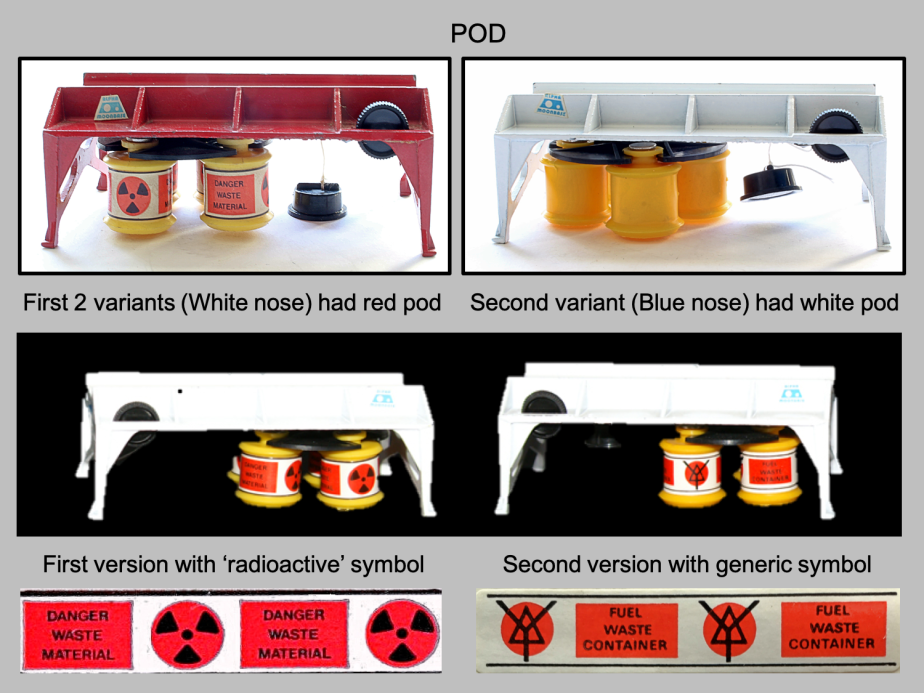
The first decals were wet transfers but were then replaced by adhesive stickers.
In 1979 the change of label design for the containers was said to be due to an 11 year old girl named Marianne Fleckery who found some of the hollow cylinders in the garden of her home in Langley Crescent, St Albans, Herts. She persuaded firemen to visit in anti-contamination suits and take the cylinders to the then-government radiation centre in Amersham. After the incident Meccano removed the radiation symbol and words.
ODDITIES AND RARITIES:
A 32 part Eagle Transporter and Freighter kit, similar to other metal Dinky Kits available at the time, was proposed but not commercially released.

In kit form and unpainted, it would have contained a single Eagle chassis but with both the transporter lab module and the freighter container pod. All that appears to survive today is the artwork for the box labelled under Dinky Die Cast Toymaker brand. The serial number was to be 1035, but this was allocated to the Striker Anti- Tank Vehicle kit in 1975 so making this a very short lived project.
BOXES:
The first Eagle Freighters came in a bubblebox with a blue base and subsequently with a yellow or white base but these were only issued for a short time.
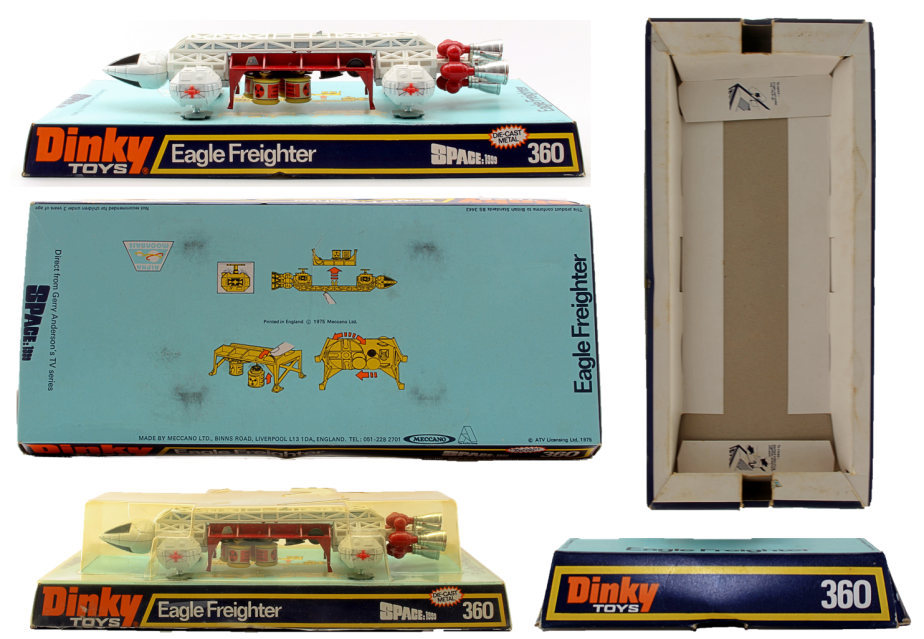
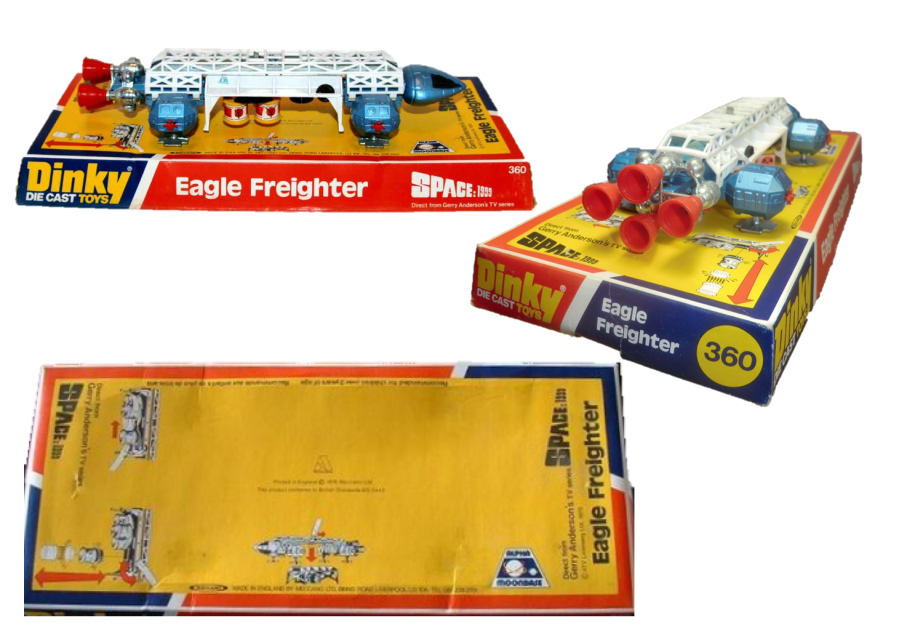
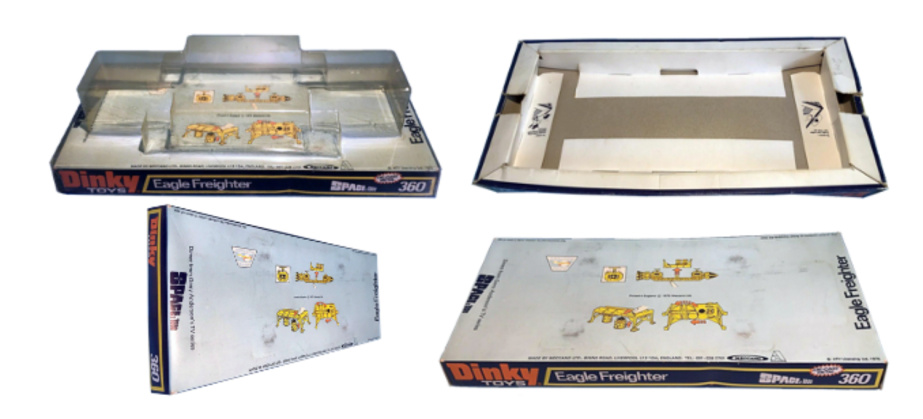
The next box type was a window hanging box. On the front it featured two actors from the series, Martin Landau (Commander John Koenig) and Barbara Bain (Dr Helena Russell) and on the back a contrived mission featuring the 353 Shado 2, the 351 Shado Interceptor and 106 Thunderbird 2.
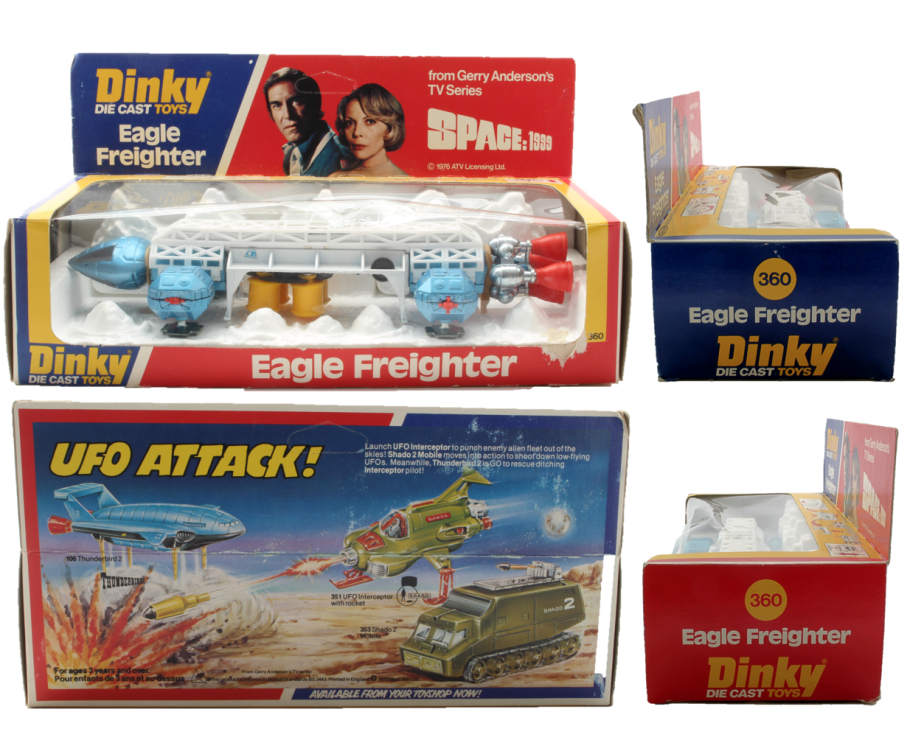
The interior was an attractive polystyrene lunar moonscape which also helped hold the model in place whilst being transported.
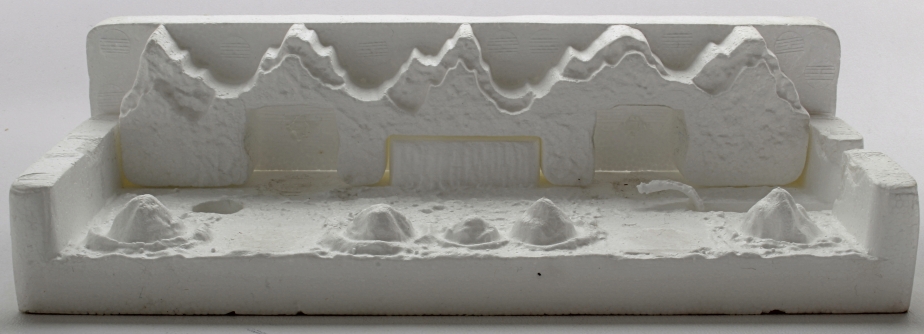
The last box did away with the foam inserts and replaced it with a simple yellow cardboard tray.
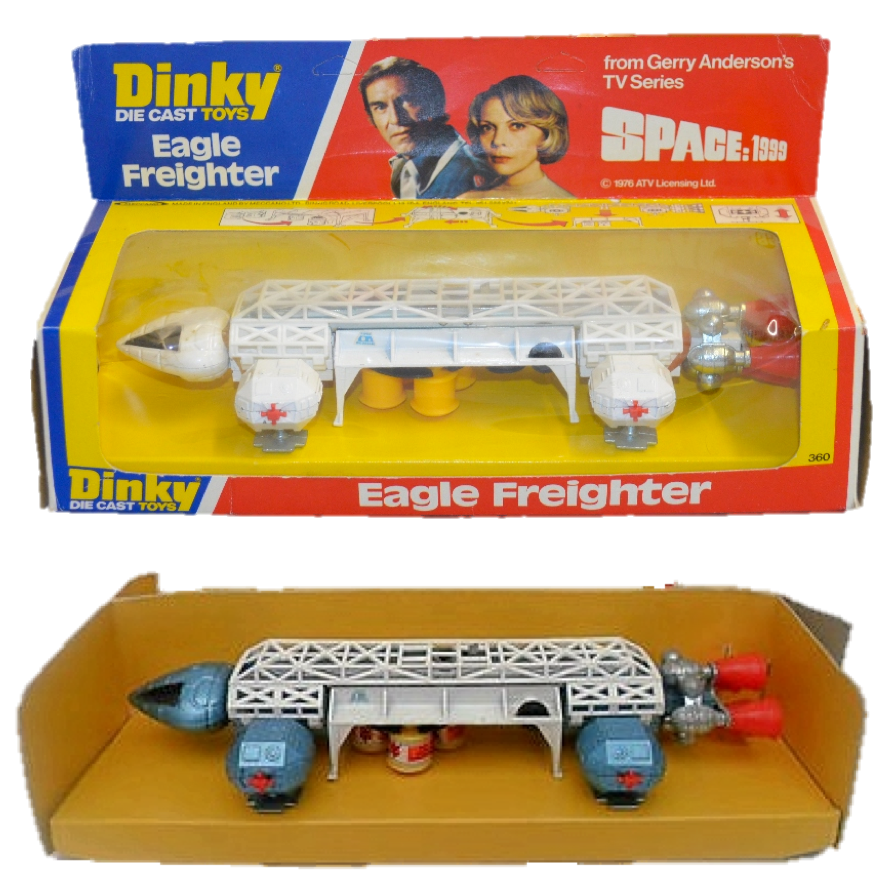
CATALOGUES:
The Eagle Freighter first appeared in the 1975 catalogue.
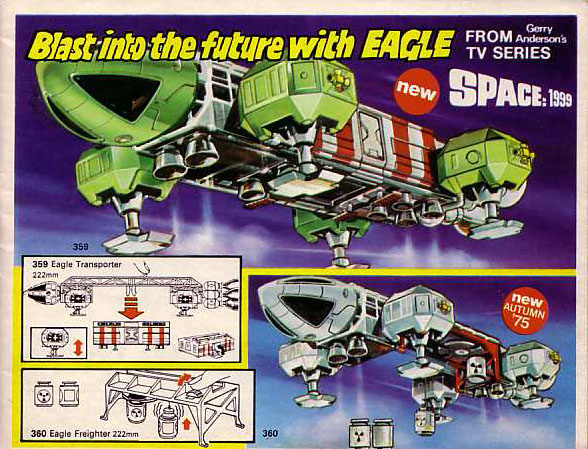
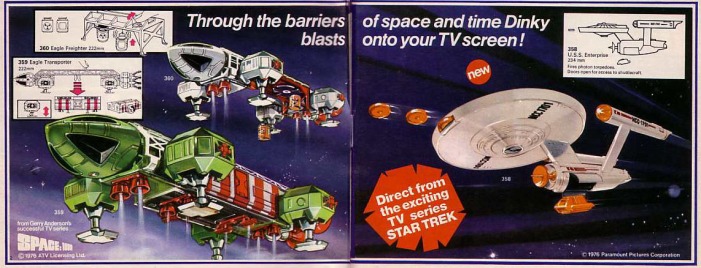
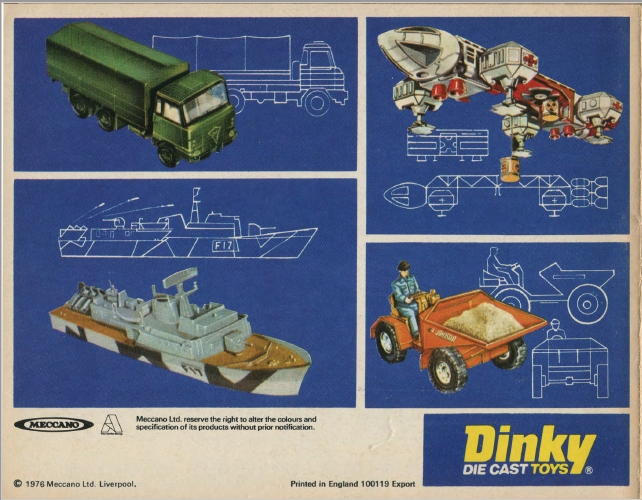
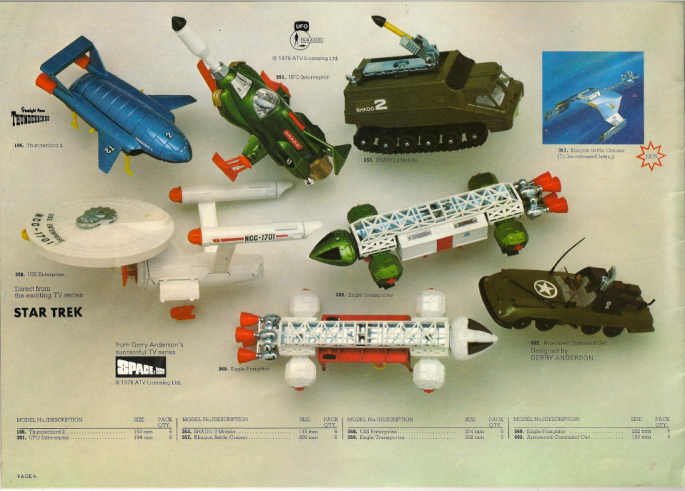
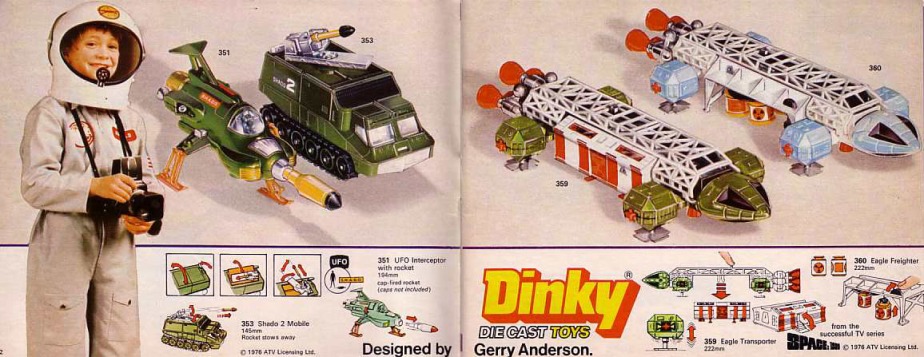
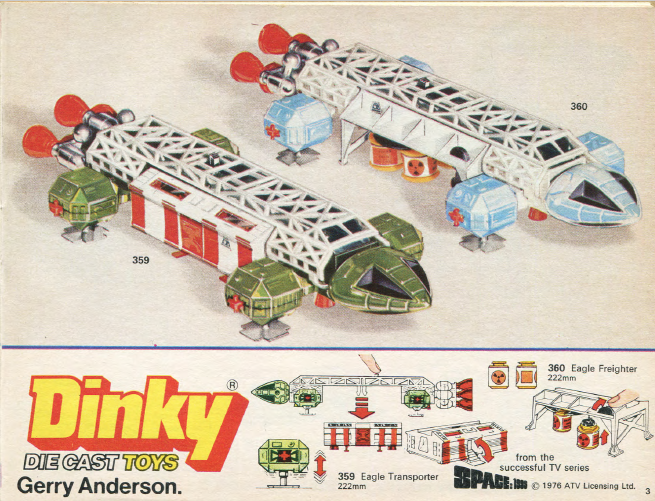
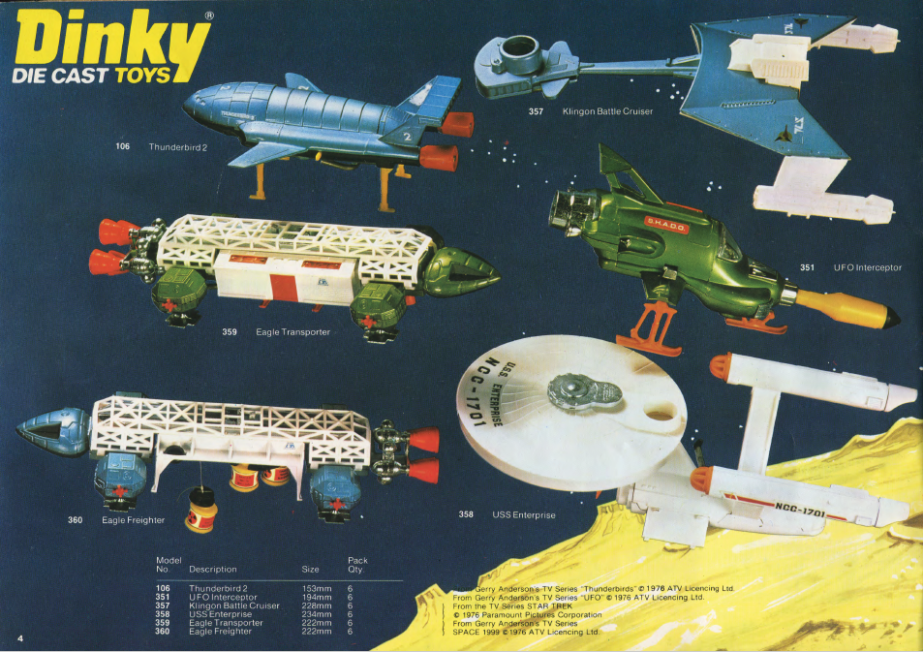
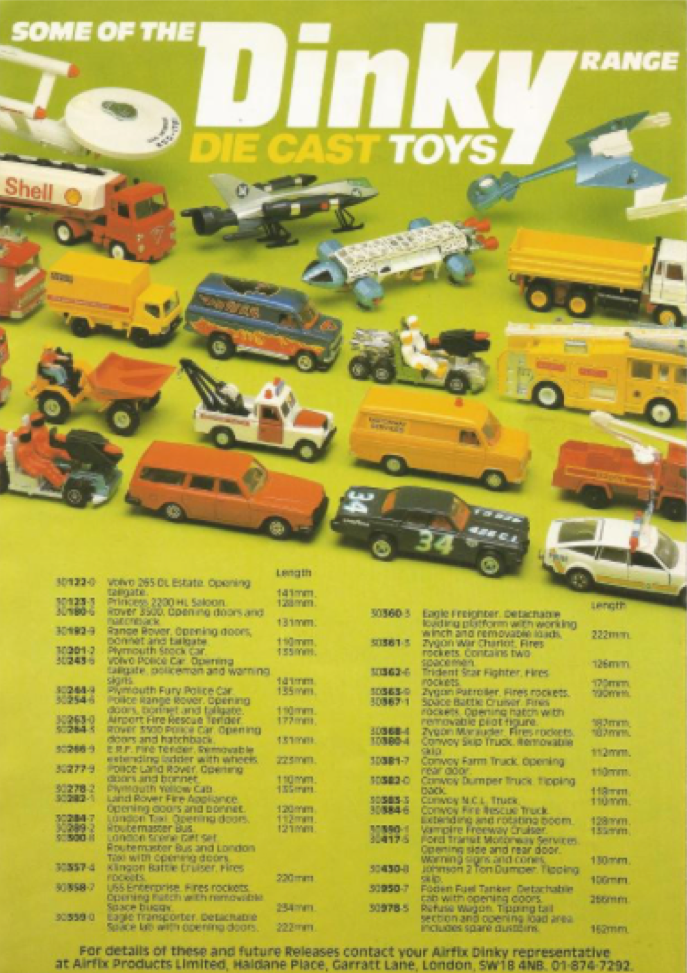
ADVERTS:
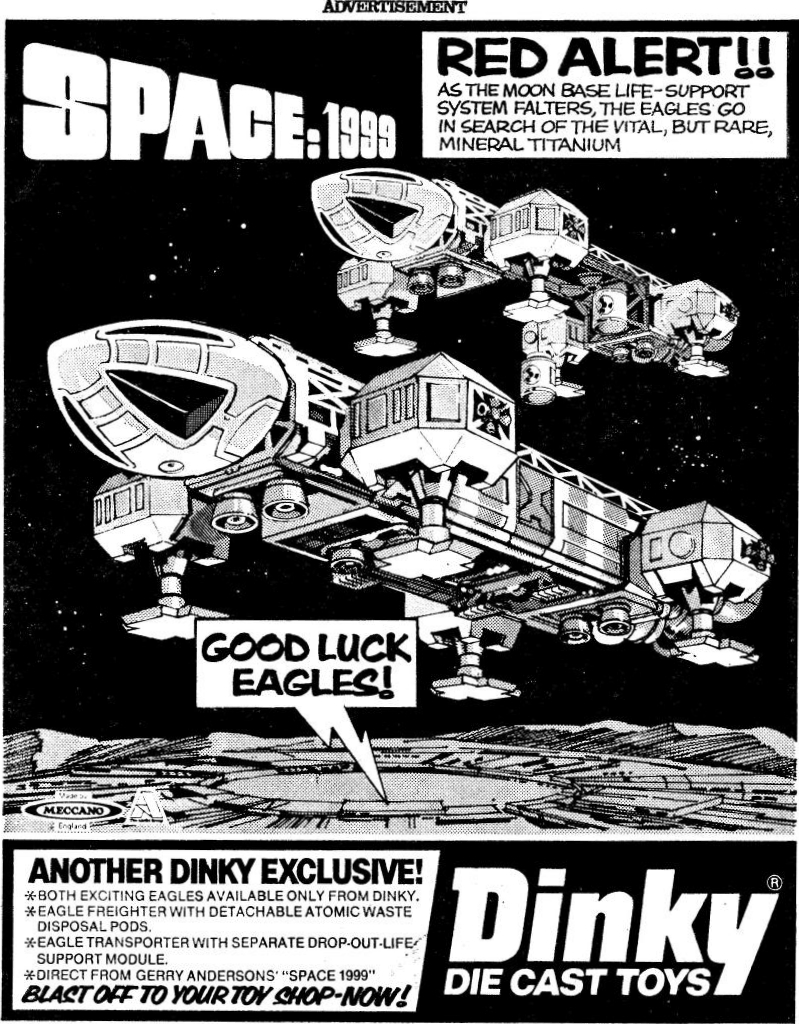
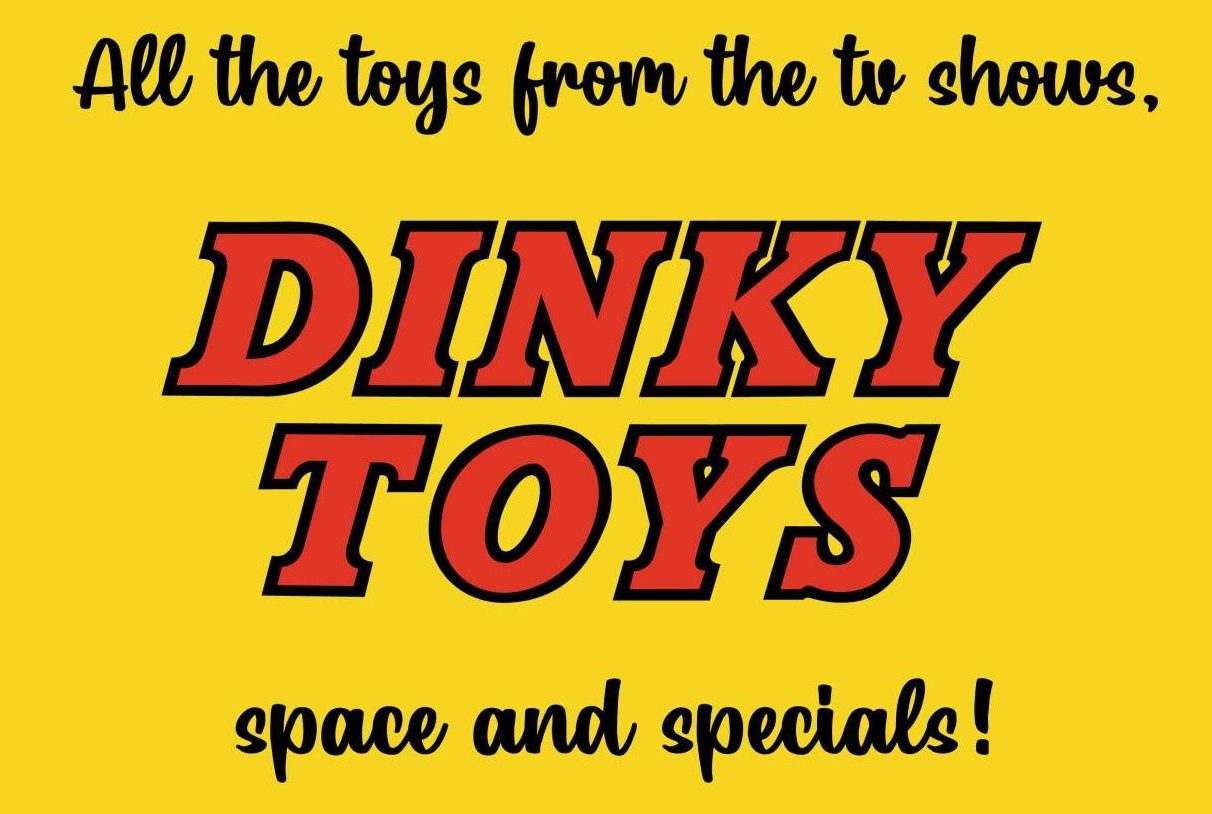
I’m afraid you got your descriptions in the “POD” photo section mixed up a bit. The white chassis had the red pod and the blue chassis had the white pod. Other than that, a very nice article!
LikeLike
Well spotted! I’ve corrected the text, thank you.
LikeLike
What month/year approx did the blue Eagle appear!?? The yellow/red card plinth is – as you correctly say the rarest packaging – and I believe the blue version first appeared with this sometime around mid 1977 ish??
LikeLike
Hi Stuart, I can’t say for certain what year the blue version appeared but 1977 seems likely as the consumer catalogue for that year shows this version for the first time. The trade version for 77 which would have been issued earlier showed the white version. Thanks for your input here. Kevin
LikeLike
Hi can you tell me what shade /type of blue the blues version is
LikeLike
The pictures here are pretty spot on. I can only describe it as a medium metallic blue. Looks lighter in tone than the green Transporter when seen side by side.
LikeLike
did you know that when they were putting together to blue one they ran out of the front end, so they had some spare green front ends left so they over sprayed them blue and used them, this only happen for a day until more stock of the front end arrived, so if you look carefully at a blue one and if its play worn you may be lucky to see the green underneath but what is really rare if the front end is the first addition one which had the struts as sometimes they by mistake mixed old and new stock.. very rare..
LikeLike
Hi Will,
Now you are going to have a lots of us scrabbling around to find our Eagle Freighters and peering at them with a magnifying glass to spot flecks of green paint!
Regarding the struts, I have seen freighters and transporters with and without struts on the white plastic girder centre piece. I understand that the first version of the transporter had no strut, later versions did and I believe the first version of transporter did and the later one not. However with Dinky I can believe that struts/no struts could have appeared on the other models as well. Cheers Kevin
LikeLike
Hi
Can you please help me. I have a green freighter, what colour is the most collectable?
LikeLike
Hi Gareth, Thank you for your note. The 360 Freighter was only produced with a white or blue body, perhaps you mean the 359 Transporter which was only produced in green. The 359 variant with yellow thrusters on the side pods and with chromed main engine thrusters is less common than the version with red side thrusters and red main engines thrusters. The cargo pod and the freighter pod fit on either model so its possible to create a green bodied freighter but they we never originally sold like this. Cheers Kevin
LikeLike
I have had a blue freighter with feet module support. Most everything else seems accurate.
LikeLike
Hi Gordon, Thank you for your note. Do you mean your blue freighter has an Eagle transporter module? If so, it has been swapped from a transporter as the fittings are the same and both modules can be interchanged. There is no evidence that Dinky released a blue eagle transporter. Cheers Kevin
LikeLike
No, I was referring to the little tab on the shoulderpods that connect to the main body of the Eagle. There were both variants of tabs and no tabs coming off of the shoulderpods of the blue Freighter Eagle. In your photo above, you refer to those tabs as feet module support.
LikeLike
Thanks for a great reference site, I know it will cause a lot of controversy, but, in the 70’s I was in “Woolworths” with my parents,and, I definitely 100% remember seeing a white and a blue variant with a transporter pod NOT the freighter pod with barrels, I was almost begging my father to buy me the white version as it was the same as the t.v program, but, as I already had the green one at home he said no,
LikeLike
Hi Jason, Thank you for your kind comment. Perhaps Dinky had briefly run short of green bodies and made up the production run using the blue version or it’s possible the shop changed the part round. Anything is possible! Cheers Kevin.
LikeLike
On the (early) white version with the main engine and VTOL nozzles in chrome, are those parts plastic or die-cast? (seems unlikely that you can chrome-plate plastic!) If they are die-cast, it is a significant variation in production method.
LikeLike
Yes they are indeed plastic. It’s a chrome paint type finish so not difficult to apply to plastic but it did not adhere that well so flakes of easily. Later models’ engines were not painted and had red thrusters. The UFO Interceptor thruster jets are also chrome covered plastic. Cheers Kevin
LikeLike
Thanks!
FYI, I just stumbled across (and bought!) a variation that you don’t mention! It has chrome nozzles and pan-head (slot) screws, but the VTOL engines are red (not worn-off chrome, originally red)! I can send some photos when I receive it, if you like…
LikeLike
This iis a great post
LikeLiked by 1 person